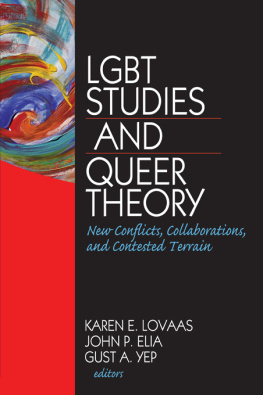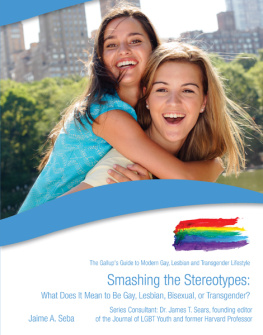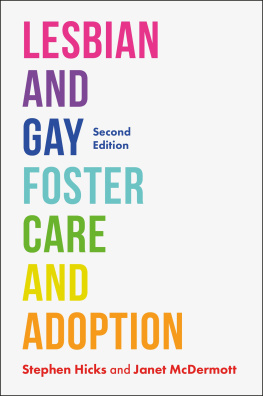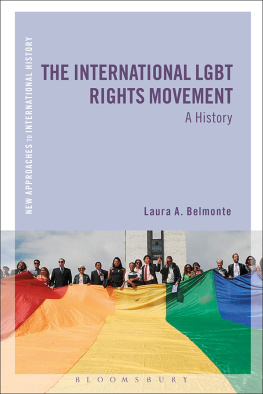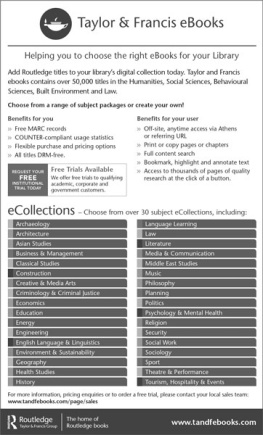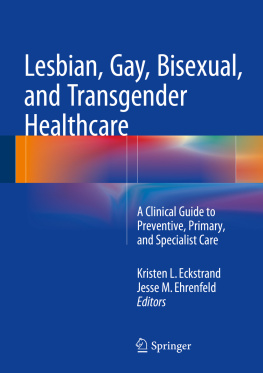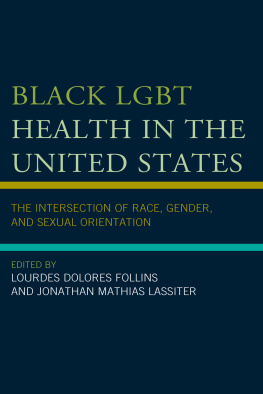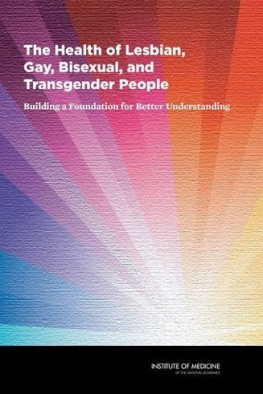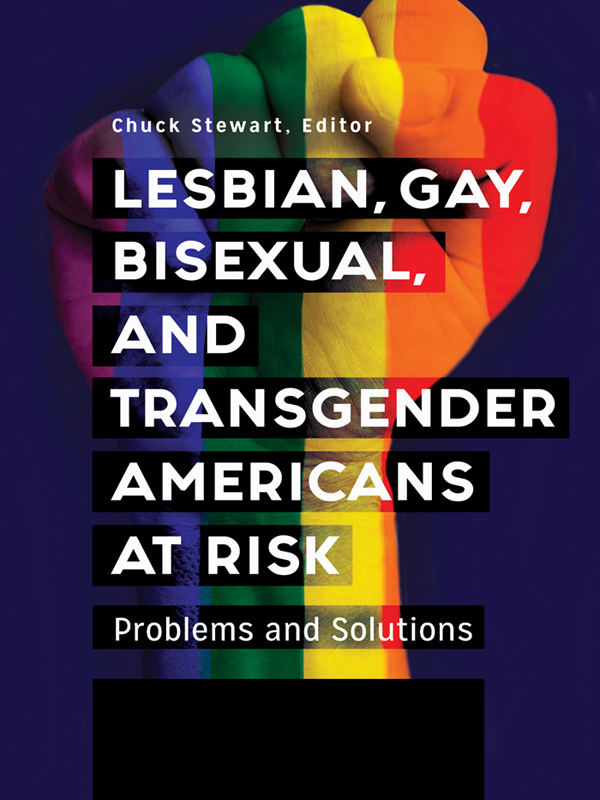Lesbian, Gay, Bisexual, and Transgender Americans at Risk
Copyright 2018 by ABC-CLIO, LLC
All rights reserved. No part of this publication may be reproduced, stored in a retrieval system, or transmitted, in any form or by any means, electronic, mechanical, photocopying, recording, or otherwise, except for the inclusion of brief quotations in a review, without prior permission in writing from the publisher.
Library of Congress Cataloging-in-Publication Data
Names: Stewart, Chuck, 1951- editor.
Title: Lesbian, gay, bisexual, and transgender Americans at risk : problems and solutions / Chuck Stewart, editor.
Description: Santa Barbara, California : Praeger, [2018] | Includes bibliographical references and index.
Identifiers: LCCN 2017029564 (print) | LCCN 2017040956 (ebook) | ISBN 9781440832369 (ebook) | ISBN 9781440832352 (set : alk. paper) | ISBN 9781440848193 (volume 1 : alk. paper) | ISBN 9781440848209 (volume 2 : alk. paper) | ISBN 9781440848216 (volume 3 : alk. paper)
Subjects: LCSH: Gays--United States--Social conditions. | Sexual minorities--United States--Social conditions. | Gay rightsUnited States.
Classification: LCC HQ76.3.U5 (ebook) | LCC HQ76.3.U5 L476 2018 (print) | DDC 306.76/60973dc23
LC record available at https://lccn.loc.gov/2017029564
ISBN:978-1-4408-3235-2 (set)
978-1-4408-4819-3 (vol. 1)
978-1-4408-4820-9 (vol. 2)
978-1-4408-4821-6 (vol. 3)
978-1-4408-3236-9 (ebook)
22 21 20 19 18 1 2 3 4 5
This book is also available as an eBook.
Praeger
An Imprint of ABC-CLIO, LLC
ABC-CLIO, LLC
130 Cremona Drive, P.O. Box 1911
Santa Barbara, California 93116-1911
www.abc-clio.com
This book is printed on acid-free paper 
Manufactured in the United States of America
Contents
VOLUME 1: CHILDREN, YOUTH, AND YOUNG ADULTS
Nicole M. Taylor and Margaret Collins
Kinga Szprengiel
Ryan OConnell and Julie Fricke
Ryan K. Schroth
Nicholas Newton
Forrest E. Clift and Casey Thelenwood
Mallory Garrett
Sarah R. Young
Cassandra Scherr
Lynn M. Hazard
Alex Dzurick
Eva M. Jones
Stephanie Chamberlin, Ryan OConnell, and Jean Scandlyn
America has been a dangerous place for gay youths. Often when children came out gay or lesbian or transgender to parents and family members, they faced being ostracized, sometimes taken to religious leaders for conversion therapy or, worse, ejected from their homes. After decades of activism by gay and lesbian rights leaders, the situation has improved vastly for families with Lesbian, Gay, Bisexual, Transgender (LGBT) parents and children. This volume of essays explores the current historical and political status of gay, lesbian, transgender, and intersex children, same-sex households, bullying, coming out in communities of color and small towns, homelessness, and more.
The United States Census Bureau estimates that slightly more than 1 percent of households are composed of same-sex couples. Of those families, about 20 percent have children. Nicole Taylor and Margaret Collins, both of the University of Illinois, explore the dynamics of same-sex households and the children that reside within these homes. Their essay, Children in Same-Sex Households, covers many of the issues related to same-sex homes, the relationship to both gay and straight family members, and many legal issues.
There are many pathways by which well-meaning gays and lesbians may become parents. Almost three-fourths of same-sex households with children indicate that it is their own biological children residing with them. Often the children come from previous heterosexual relationships or marriages. More and more children are being adopted or provided foster parenting by same-sex couples. Same-sex couples, to fulfill their desire to have a family, are embracing new fertility treatments such as artificial insemination and surrogacy.
Some people express concerns about the psychosocial outcomes of children raised by same-sex couples. Extensive research over the last 40 years has resulted in the American Academy of Pediatrics, the American Psychological Association, the American Psychiatric Association, and other prestigious scientific organizations issuing reports that confirm that children raised by same-sex couples are equally as adjusted as those raised by opposite-sex couples. Further, they support marriage equality because it would give children with same-sex parents the social and economic benefits afforded by children raised by opposite-sex parents.
About the only negativity seen in children of same-sex parents is the level of discomfort in revealing their parents sexual orientation. Some children of lesbian, gay, or transgender parents are hesitant to share their family status out of fear of being stigmatized. Sometimes children fear being labeled LGBT because their parents are. Regardless, children raised in same-sex households achieve equally well in school academics, and their psychosocial skills are equally developed.
Bullying and harassment are real concerns for children of LGBT families. For some children, revealing that they have same-sex parents leads to negative name-calling at school. For other children, the strength exhibited by their same-sex parents to live openly as they do provides a role model for navigating an otherwise nasty world. Antibullying programs are discussed much later in this volume.
There are benefits to having same-sex parents. Most importantly, same-sex couples who decide to have children (whether their own or through adoption) are making a conscious choice to be parents. Their children are not accidents, and as such, same-sex parents have been measured to be more motivated and more committed to their children. Further, since same-sex relationships tend to be more tolerant, open-minded, and equitable (such as in dividing household responsibilities or in parental style), relying on each partners preferences and interests and not on gender roles, children in such households learn to be more tolerant, open-minded, and equitable in their relationships.
Overall, children raised by parents who are Lesbian, Gay, Bisexual, Transgender, Queer (LGBTQ) do as well as children raised by heterosexual parents. Some children do not fare well with the potential stigma associated with LGBTQ families, whereas other children embrace their parents love and courage and apply it to their own lives.
****
In the essay Children Coming Out: The Process of Self-Identification, Kinga Szprengiel, an educator and counselor working with LGBTQ youth experiencing homelessness in New York City, explores the coming-out process in ever-younger children. Historically, young people came out lesbian or gay in their early twenties. Recent research has shown that the age of coming out has dropped to the early teens. What are some of the social dynamics that have allowed this early identification? What are some of the challenges faced by children coming out at earlier ages? Is this trend seen with transgender and intersex children?
A major social shift occurred in the last 20 years regarding sexual and gender presentation. LGBT characters and stories became mainstream with shows such as Will and Grace and MTVs Real World, major movie and music stars came out, the press covered more and more LGBT issues, federal marriage equality legislation was achieved, and, most importantly, LGBT information flooded the Internet. Todays youths are exposed to more positive language and images concerning LGBT topics and people than ever before, and these help children to formulate their identities at earlier ages. Unfortunately many families, schools, religious groups, youth sporting organizations, and the like are unprepared for such young children acting on their sexual and gender identity, and one that is not heterosexual.

![Chuck Stewart Lesbian, Gay, Bisexual, and Transgender Americans at Risk [3 Volumes]: Problems and Solutions](/uploads/posts/book/129596/thumbs/chuck-stewart-lesbian-gay-bisexual-and.jpg)

